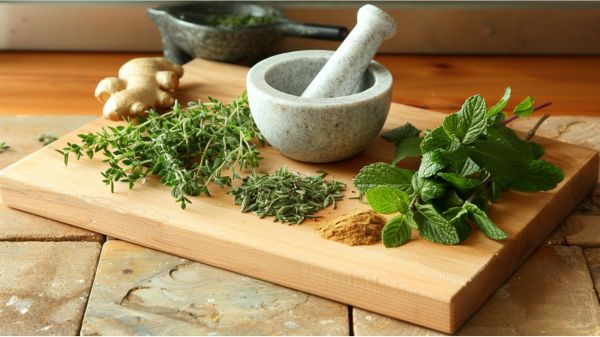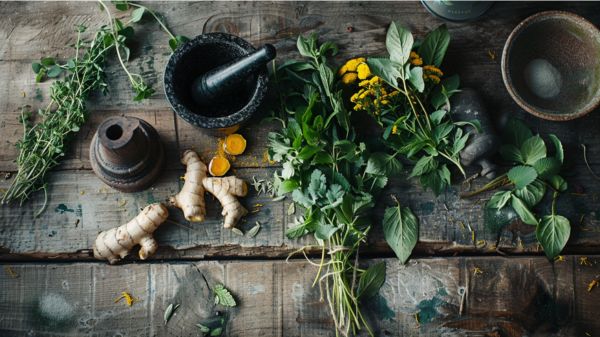10 Powerful Medicinal Plants: The Forgotten Ancient Healing Herbs
Are you ready to unlock the hidden secrets of nature’s healing power? Dive into a world of forgotten ancient healing herbs that can rejuvenate your body and soul. Discover the magic of mullein, feverwort, arnica, and more.
These powerful medicinal plants, once revered by our ancestors, have been lost in the tide of time. But fear not, for we are here to guide you on a journey of knowledge and freedom. Embrace the wisdom of the past and unleash the healing potential within you.
The Healing Power of Mullein
Mullein is one of versatile medicinal plants with various medicinal uses. It has been used for centuries as a natural remedy for respiratory health, particularly for asthma and chest congestion. This herb is known for relieving chest congestion, treating rashes, and making a sedative tea.
Mullein is also effective in alleviating joint pain and swelling, making it a versatile herb for those seeking relief from arthritis or other inflammatory conditions. Additionally, mullein tea has calming effects and acts as a natural sedative, making it a great option for those looking to unwind and relax.
Furthermore, mullein is a multi-purpose herb for skin conditions and rashes. It provides relief and promotes healthy skin. With its numerous benefits, mullein is a valuable herb of medicinal plants for maintaining overall well-being.
Feverwort: The Fever Fighter
Feverwort is commonly available in stores as tea or dried leaves and flowers. This powerful medicinal herb has been used for centuries to treat fevers and promote overall well-being. Drinking feverwort tea can provide numerous benefits, including reducing fever symptoms, relieving headaches, and soothing respiratory issues. The leaves and flowers of feverwort can also be used in various remedies, such as poultices for skin irritations and infusions for digestive problems.
However, it is important to note that like any herb, feverwort may have side effects if not used properly. It is recommended to consult with a healthcare professional before using feverwort, especially if you are pregnant, breastfeeding, or have any underlying medical conditions. When using feverwort, it is crucial to follow the recommended dosage to ensure safe and effective results.
Arnica: a Sunflower With Healing Properties
Arnica, a member of the sunflower family, is often used as a salve for bruises, muscle aches, sprains, and arthritis. This powerful herb has been recognized for centuries for its remarkable healing properties.
Arnica’s active compounds, such as helenalin and flavonoids, work together to reduce inflammation, alleviate pain, and promote healing. When applied topically, arnica stimulates blood flow to the affected area, helping to reduce swelling and bruising. It can also improve joint mobility and relieve muscle tension.
Additionally, arnica has been found to have antibacterial and antifungal properties, making it a versatile natural remedy. However, it is important to note that arnica should not be ingested internally, as it can be toxic. As with any herbal remedy, it is always recommended to consult with a healthcare professional before use.
The Therapeutic Uses of Blackberry
Blackberry is a versatile plant found along trails and roads. It has been used for its therapeutic benefits in treating inflammation, joint pain, and upset stomach.
The benefits of blackberry tea are well-known. It can help to reduce inflammation and ease joint pain. Additionally, blackberry leaf poultice can be applied topically to treat skin rashes and promote healing.
For digestive issues, blackberry root tea has been found to be effective in soothing the stomach and relieving discomfort. Furthermore, blackberry can serve as a natural remedy for sore throat. Chewing the leaves can help to alleviate pain and reduce inflammation.
With its wide range of uses, blackberry is one of valuable medicinal plants that offers numerous health benefits.
Common Sumac: A Medicinal Marvel
Common Sumac, a widely available plant found almost everywhere, offers a range of health benefits. It can relieve sore throats, provide a good source of Vitamin C, and help alleviate diarrhea. This medicinal marvel has been used for centuries in traditional medicine for its healing properties.
In the past, common sumac was commonly used as a natural remedy for sore throats and fevers. Its bark was boiled to make a soothing drink that relieved throat pain. The berries, high in Vitamin C, helped to reduce fevers.
Additionally, common sumac was known to have a calming effect on the digestive system, making it an effective remedy for diarrhea.
Despite its historical significance, common sumac has been largely forgotten in modern herbal medicine. However, exploring its medicinal benefits can reveal a forgotten gem that can provide relief for various health conditions.
The Beneficial Aspects of Black Cohosh
If you’re looking for a natural way to induce labor or relieve menstrual pain and cramping, black cohosh may be a beneficial option for you. Here are four important aspects of black cohosh that you should know:
- The importance of black cohosh in women’s health: Black cohosh has been one of medicinal plants used for centuries by Native American tribes to treat various women’s health issues, including menstrual pain, hot flashes, and hormonal imbalances.
- The various uses of black cohosh: Apart from its role in women’s health, black cohosh has also been used to relieve rheumatism, backache, cough, and insomnia. It is commonly consumed as a decoction or taken in the form of supplements.
- The historical significance of black cohosh: Black cohosh has a rich history and has been used by indigenous cultures for generations. It was later adopted by European settlers and continues to be widely used today.
- The potential side effects of black cohosh: While black cohosh is generally safe for most people, it may cause side effects such as stomach discomfort, dizziness, and headaches. It is important to consult with a healthcare professional before starting any new herbal remedy.
In addition to black cohosh, there are alternative remedies for menstrual pain and cramping, such as ginger, chamomile, and evening primrose oil. It is always recommended to explore multiple options and choose the one that suits you best.
Yarrow: More Than a Pretty Plant
Yarrow, a versatile plant with numerous benefits, offers more than just its aesthetic appeal.
Throughout history, yarrow has played a significant role in traditional medicine and herbal remedies. Cultivated and harvested for its medicinal properties, this medicinal plant has been used by different cultures for various purposes.
In traditional medicine, yarrow has been used to treat wounds and stop bleeding due to its ability to constrict blood vessels. It has also been used to aid digestion and clear up acne.
Yarrow cultivation is relatively easy as it thrives in sunny locations, along roads, fields, waste zones, and gardens. Harvesting the plant can be done by cutting the fresh leaves or extracting the juice to stop internal bleeding.
With its historical uses and potential health benefits, yarrow continues to be valued in the world of herbal medicine.
Ginseng: A Prized Cherokee Medicine
Now that you’ve learned about the various uses of yarrow, let’s dive into the world of ginseng, one of medicinal plants that holds a special place in Cherokee ginseng traditions.
- Ginseng cultivation techniques: The Cherokees have long cultivated ginseng, carefully tending to its needs. They have perfected the art of growing this precious plant in the shade and moist soil, providing it with the optimal conditions for growth.
- Ginseng’s role in traditional Cherokee medicine: Ginseng has played a crucial role in traditional Cherokee medicine for centuries. It has been used to treat a wide range of ailments, including headaches, cramps, colds, flu, and infections. It has also been used as a poultice for boils and to stimulate the appetite in the elderly.
- Medicinal properties of ginseng: Ginseng is rich in medicinal properties. It contains compounds called ginsenosides, which have been found to possess anti-inflammatory, antioxidant, and immune-boosting properties. These properties contribute to its effectiveness in treating various health conditions.
- Modern uses of ginseng: Today, ginseng continues to be highly valued for its health benefits. It is commonly used in herbal supplements and natural remedies for its potential to improve mental and physical performance, boost energy levels, and enhance overall well-being. Its popularity extends far beyond the Cherokee community, with people from all walks of life incorporating ginseng into their daily routines.
Skullcap: A Potent Member of the Mint Family
Skullcap, a member of the mint family, has been one of medicinal plants used for centuries for its potent medicinal properties. It has been traditionally used to start menstruation, treat diarrhea, breast pain, and kidney problems.
In recent years, scientific research has started to uncover the many benefits of skullcap. Studies have shown that skullcap may help reduce anxiety and promote relaxation.
One way to enjoy the benefits of skullcap is by making a tea. To make skullcap tea, simply steep 1-2 teaspoons of dried skullcap leaves in hot water for 10-15 minutes. This soothing tea can be enjoyed throughout the day to help calm the mind and body.
With its rich history and promising research, skullcap is a valuable herb that offers freedom from various ailments.
Goldenseal: A Golden Healer
If you’re looking for a versatile herb with a golden touch, goldenseal may be just what you need. This powerful herb has been one of medicinal plants used for centuries for its many health benefits and healing properties.
Here are four ways you can make use of goldenseal:
- Goldenseal Tea: Brew a cup of goldenseal tea to soothe digestive issues, boost your immune system, and promote overall wellness.
- Goldenseal Benefits: Goldenseal is known for its antimicrobial and anti-inflammatory properties, making it a great natural remedy for conditions such as colds, flu, and respiratory infections.
- Goldenseal Uses: Goldenseal can be used topically to treat skin conditions like eczema, acne, and wounds. It can also be used as a mouthwash to alleviate gum inflammation and oral infections.
- Goldenseal Remedies: Goldenseal can be used as a natural remedy for various ailments such as urinary tract infections, sinusitis, and allergies.
With its wide range of uses and healing properties, goldenseal is a valuable herb to have in your natural medicine cabinet.
Conclusion
Now you possess the key to unlocking the ancient secrets of powerful medicinal plants. These forgotten herbs, such as mullein, feverwort, arnica, blackberry, common sumac, yarrow, ginseng, skullcap, and goldenseal, hold the potential to heal and restore your body.
By harnessing their unique properties and following the traditional methods of preparation, you can experience the healing touch of nature’s medicine. Embrace these botanical wonders and embark on a journey towards holistic well-being.
Let the wisdom of our ancestors guide you towards a healthier, happier life!







5 Comments
Comments are closed.